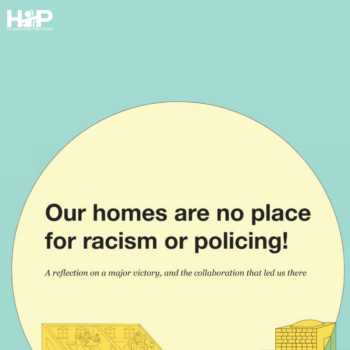| By Jonathan Heller |
HIP recently started the Public Health and Equity Cohort, a group of twelve emerging leaders from public health agencies around the country who are coming together to build their leadership to advance equity within their departments. In developing the 15-month curriculum for the Cohort, we had to think through and articulate a strategy for how health departments could advance equity. Our strategy is based on our experience working with public health departments and with community groups to make change.
It is important to first recognize that inequity exists because groups who benefit from it hold power. Those groups often include rich, white men interested in maintaining their status or expanding and consolidating their wealth and power. They also include corporations – usually run by rich, white men – who benefit from cheap labor and lax regulation. To maintain power, they use racism, classism, and sexism to divide those who should be united in working for change.
To move toward equity, those who want to change the system need to build power. How do allies of those who are negatively impacted by inequities – specifically allies in public health – support the work of building power? Our answer is through using an inside-outside strategy.
On the inside, health agencies, both leadership and staff, must first build their understanding of equity, including racism, classism, sexism and other forms of oppression. This can be done through internal dialogues and trainings such as those that have been done at health agencies in Alameda County, Calif., and Ingham County, Mich., at the state level in Minnesota, and elsewhere. With everyone in the agency involved, it is less likely that a change in leadership would undo this understanding and emphasis.
These agencies then must build the will to act on that understanding, beginning by changing the narrative about what leads to good health – for example, from a medical model that focuses on health care to the social determinants of health – and then using the power of the agency to advance equity. As I’ve written before, this takes tremendous leadership that must be willing to take risks. The model is power with – public health working in close and inclusive partnership with those facing inequities – rather than power over, in which public health institutions try to amass their own power.
But by itself a health agency will never have enough power to advance equity. Political forces favoring the status quo will slap down an agency acting alone. This is where the outside component of the inside-outside strategy to advance health equity comes in.
A demand to address equity should come from the community – from those facing inequity exercising their democratic rights. Health agencies must build relationships and work closely with community groups that can demand change and hold the agency and others in government accountable to their needs. They can also come to the rescue in tough political situations and have the health agency’s back.
Not every community group can support this kind of work. Best suited are base-building (or grassroots) organizations, staffed by community organizers. A base-building group is one that:
- Brings people who identify as part of a community together to solve problems they themselves identify. These people often become members of the organization and are referred to as its base.
- Helps a community identify common problems or change targets, mobilize resources, and develop and implement strategies to reach their collective goals.
- Works to develop civic agency – the capacity of citizens to work collaboratively across differences to address common challenges, solve problems, and create common ground ¬– among individuals and communities to take control over their lives and environments. Ultimately, these groups are working to strengthen democratic processes.
So, for the outside part of the strategy, health agencies must learn how to partner with and support these kinds of base-building community organizations, who typically work to address the social determinants of health (even though they may not call them that). This is not easy, but health agencies from San Francisco to Kansas City to Boston have been leading the way.
This inside-outside strategy reflects at least one way to build the power to advance equity in a lasting and sustainable manner. Members in our Public Health and Equity Cohort will be exploring what this all means for their work, and trying to understand how to grow in this way.
To learn more about how these some of these ideas have been implemented, see:
- A brief we wrote about Alameda County Public Health’s approach to addressing equity.
- Two books by the National Association of County and City Health Officials – Expanding the Boundaries: Health Equity and Public Health Practice and Tackling Health Inequities Through Public Health Practice: A Handbook for Action.
- Community Organizing and Community Building for Health and Welfare, by Meredith Minkler.




